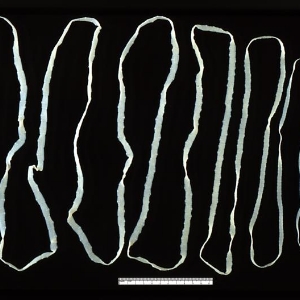
For the first time, researchers have mapped the genomes of tapeworms to reveal potential drug targets on which existing drugs could act. The genomes provide a new resource that offers faster ways to develop urgently needed and effective treatments for these debilitating diseases.
Tapeworms cause two of the World Health Organization's 17 neglected tropical diseases; echinococcosis and cysticercosis. The team sequenced the genomes of four species of tapeworm to explore the genetics and underlying biology of this unusual parasite. As an adult it can live relatively harmlessly in the gut, but its larvae can spread through the body with devastating effects. The larvae form cysts in the internal organs or tissues of humans and other animals. These cysts proliferate or grow in the body, much like cancer. In some species this can cause complications such as blindness and epilepsy, with others it may lead to death.
"Tapeworm infections are prevalent across the world and their devastating burden is comparable to that of multiple sclerosis or malignant melanoma," says Dr Matthew Berriman, senior author from the Wellcome Trust Sanger Institute. "These genome sequences are helping us to immediately identify new targets for much-needed drug treatment. In addition, exploring the parasites' full DNA sequences is driving our understanding of its complex biology, helping the research community to focus on the most effective drug candidates."
How the study was done
Normally, researchers identify new targets for drugs to combat diseases by comparing a pathogen's genome sequence with the human host's DNA to find differences between them. This time, however, the team deliberately looked for similarities between humans and the parasite because both are multicellular and the tapeworm is evolutionarily similar to humans.
By finding similarities, the scientists found targets that exploit the activities of existing drugs. Identifying treatments already on pharmacy shelves and approved for other uses should save time and money.
Many of the processes of these diseases parallel those of cancer tumours, suggesting that tapeworms could be susceptible to cancer treatments, such as suppressing cell division and preventing DNA replication. When the team compiled a list of most likely targets for drug treatment, many of them were the same targets as pre-existing cancer chemotherapies.
Combining biological knowledge with the full genome also revealed other promising targets for existing drugs. Over time, tapeworms have lost the ability to synthesise the necessary fats and cholesterol that are crucial for larvae development. Instead, they scavenge and modify them from their hosts. The most active genes in the tapeworm are central to this important scavenging process because they produce the proteins that bind fats or are the precursors of fatty acid binding proteins. Disrupting these proteins with current drugs may prove an effective treatment.
"We have developed new method to grow tapeworm cells in the laboratory and we're screening these cells against many of the potential drug treatments identified from the genomes," says Professor Klaus Brehm, co-author from the University of Würzburg, Germany. "Given that so few successful treatment options are currently available, we hope that we will be able to identify and validate existing drug candidates, relieving the burden of this debilitating, overlooked disease."
What the study found
As well as identifying targets that existing drugs could act on, the team discovered why other treatments have been unsuccessful. For example, targeting the acetylcholinesterases (enzymes present in the central nervous system) has been successful in treating malaria and fluke worms, but was ineffective against tapeworms.
Analysing gene activity showed that the production of acetylcholinesterases is surprisingly low in tapeworm cysts, explaining why their disruption had no effect.
For one tapeworm species, the team managed to assemble essentially complete chromosomes. Surprisingly, this revealed a similar chromosomal organisation with the distantly related flukes. The quality and high level of genomic sequence in this study also enabled the team to examine the evolutionary genetic losses and gains of tapeworms, providing them with hundreds of potential drug targets and eliminating those targets that are unlikely to work against tapeworm infection.
"We need to take advantage of this genetic sequence data to find new and improved ways of coping with this problem that devastates much of the developed and developing world," says Professor Peter Hotez, Dean of the National School of Tropical Medicine at Baylor College of Medicine and Editor-in-Chief of PLoS Neglected Tropical Diseases.
"Open access to these complete genomes will accelerate the pace in which we find alternative tools and treatments to combat tapeworm infections."




 Publications
Publications
 Partners
Partners










